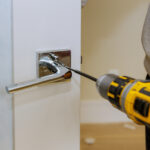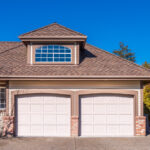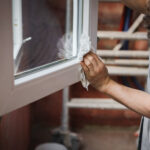Learn about the hidden dangers of broken garage door cables, how they affect your home’s safety, and what Canadian homeowners should do to prevent costly damage or injury. Discover practical tips, expert advice, and when to call in the pros.
Understanding the Role of Garage Door Cables
What Are Garage Door Cables?
Garage door cables are essential components that help control the movement of your garage door. They work in tandem with the springs to lift and lower the door smoothly and safely. These cables are typically made of strong, twisted steel wire and are built to handle the weight of your garage door.
However, like all mechanical parts, garage door cables can wear out over time. In Canada’s fluctuating climate—especially in regions like Ontario, where winters can be harsh—cables may become brittle or rusted, increasing the risk of failure.
Why Are They So Important?
Garage door cables balance the heavy load of the door. Without them, the springs alone cannot properly support the weight. If a cable snaps, the door may fall suddenly, creating a serious safety hazard. Additionally, a damaged cable can cause the door to tilt or become stuck, leaving your garage exposed to weather and intruders.
Types of Garage Door Cables
There are generally two types of cables used in residential garage doors across Canada:
- Lifting Cables: These are connected to the bottom corners of the door and help raise it.
- Safety Cables: These run through the extension springs and prevent the springs from flying off if they break.
Both types are equally important for safe, reliable garage door operation.
The Dangers of Broken Garage Door Cables
Risk of Personal Injury
A broken garage door cable can be extremely dangerous. When a cable snaps, the door may drop unexpectedly, potentially injuring anyone standing nearby. Even a lightweight door can cause significant harm when it falls from a height.
Children and pets are especially vulnerable in these situations. That’s why it’s crucial for homeowners to recognize the warning signs of cable wear and act quickly.
Damage to Vehicles and Property
If your garage door cable breaks while the door is moving, your car could be caught in the path. This can result in dents, broken windshields, or worse. In some cases, the door could also damage other items stored in your garage.
Repairing these damages can be expensive—and unnecessary if the issue was caught in time.
Security Risks
When a garage door can’t open or close properly due to a broken cable, your home becomes more vulnerable to break-ins. Thieves often look for easy access points, and a half-open or jammed garage door is an open invitation.
If you’re searching for “garage doors near me” after a cable issue, it’s likely you’re already facing a security concern. Acting fast can help protect your home and family.
Compromised Garage Door Opener
A broken cable puts additional strain on your garage door opener. Whether you’re using a Genie garage door opener or another brand, the motor is not designed to lift the full weight of the door alone. This can lead to premature motor failure or damage to the opener’s internal components.
Replacing an opener is far more costly than replacing a cable. If you notice your garage door opener remote struggling to lift the door, it could be a sign of a cable issue.
Common Signs of a Broken or Failing Cable
Uneven Door Movement
One of the first signs of a failing cable is that your garage door opens unevenly. You might notice one side rising faster than the other, or the door getting stuck midway. This often indicates that one of the cables has snapped or become loose.
Loud Noises or Jerky Movements
If your door makes loud banging or scraping sounds while operating, it could be struggling due to a faulty cable. Jerky or shaky movements are also red flags. These issues should not be ignored, as they often signal that the door is under unsafe stress.
Slack or Frayed Cables
You can often identify cable issues through a visual inspection. Frayed wires or cables hanging loosely from the door mechanism are clear signs that replacement is needed. If you see any rust or corrosion—particularly in damp regions like Mississauga or Brampton—it’s time to call in a professional.
Door Won’t Open or Close Fully
If the door stops midway or won’t move at all, it could be due to a snapped cable. This issue is especially inconvenient during winter when you need quick access to your vehicle. Cold temperatures can exacerbate cable problems, making timely repairs even more critical.
What Causes Garage Door Cables to Break?
Wear and Tear Over Time
Cables are under constant tension every time you open or close your garage door. Over time, this tension leads to metal fatigue. In most cases, cables last 5–10 years depending on usage and maintenance.
In high-use households—like multi-vehicle homes or those using the garage as a main entry point—cables may wear out faster.
Rust and Corrosion
Canada’s winters can be brutal on garage door systems. Moisture, road salt, and temperature fluctuations contribute to rust and corrosion. This weakens the integrity of the cables and leads to premature failure.
If you live in areas like Mississauga or Brampton, where winter road salt is common, it’s a good idea to inspect your cables regularly.
Poor Installation or Low-Quality Materials
Not all cables are created equal. Cheap, low-grade cables may save you money upfront, but they often lack the strength and durability needed for long-term use. Improper installation can also lead to misalignment, increasing wear and tear.
If you had a new garage door installed recently and are experiencing issues, it might be worth checking the quality of the parts used. If you need expert installation, Fortify Services uses only premium-grade materials that meet Canadian standards.
Improper Maintenance
Regular maintenance helps extend the life of your garage door cables. This includes visual inspections, lubrication of moving parts, and keeping the area free of debris. Skipping maintenance increases the risk of sudden failures, especially during extreme weather.
We recommend scheduling an annual inspection with a certified technician. Contact our certified technicians to learn more about our maintenance services in your area.
Incorrect Cable Tension
If cables are too tight or too loose, they won’t work effectively. Improper tension can strain the springs and opener motor, leading to early wear or breakage. This is why DIY repairs can be risky for homeowners unfamiliar with garage door mechanics.
Always ensure cables are tensioned correctly, or better yet, let a professional handle it.
Why DIY Repairs Can Be Dangerous
High Tension Components
Garage door cables are under high tension, especially when the door is closed. Attempting to adjust or replace them without the proper tools and knowledge can lead to serious injury. Even seasoned DIYers risk mishandling the springs or cable drums.
Incorrect Installation Risks
Improper reinstallation of cables can cause the door to behave unpredictably. This includes sudden drops, jamming, or even damaging the garage door opener. If you’re unsure, it’s always safer to call a pro.
Looking for professional garage door repair services in Ontario? Fortify Services proudly serves homeowners across Mississauga, Brampton, and beyond.
Voiding Warranties
Many garage door systems come with manufacturer warranties that become void if the system is tampered with. By attempting a DIY fix, you could lose your warranty protection, leaving you on the hook for future repairs.
When to Call a Professional
If you notice fraying, hear grinding noises, or your door isn’t operating smoothly, it’s time to bring in a qualified expert. Fortify Services offers fast, reliable service to help you avoid costly damage and dangerous situations.
Need help now? Learn more about our maintenance services and see how we can help keep your garage door in peak condition.
Preventative Measures to Avoid Cable Failure
Regular Inspections
One of the most effective ways to prevent broken garage door cables is by conducting regular inspections. Canadian homeowners should check their garage door systems at least twice a year—ideally in the spring and fall. These seasonal checks are especially important in areas like North York, Mississauga, and Brampton, where weather conditions can accelerate wear and tear.
When inspecting your cables, look for signs of:
- Fraying or broken strands
- Rust or corrosion on the metal
- Loose or unravelling ends
- Slack or misalignment on the drum
If you’re unsure what to look for, it’s best to rely on professional garage door repair services to ensure your system is operating safely.
Lubrication and Cleaning
Garage door cables don’t move as much as rollers or tracks, but they still benefit from occasional lubrication. Use a silicone-based lubricant to reduce friction and repel moisture, which helps prevent rust. Avoid using grease, as it can collect dust and debris that may interfere with the cable’s performance.
Cleaning is also essential. Salt and dirt from Canadian roads can build up on your garage door hardware, especially during winter. Wipe down cables gently using a dry cloth and inspect them for any signs of corrosion.
Reinforce Your Garage with Insulation
Cold weather is tough on garage door components. Installing a garage door insulation kit helps regulate temperature and reduce moisture buildup that can lead to cable rust. Insulated doors also put less strain on the cables and opener, extending the life of the entire system.
If you’re upgrading your garage, consider pairing insulation with weather stripping and proper sealing to protect against the elements.
Upgrade to Higher-Quality Components
If your current garage door setup includes low-grade cables or outdated hardware, it might be time for an upgrade. Investing in high-tensile cables and weather-resistant materials is a smart move, especially in Canada’s unpredictable climate.
Planning a full garage door replacement? Fortify Services offers expert installation with durable, Canadian-grade components built to withstand harsh winters and heavy use.
How Weather Impacts Garage Door Cables
Cold Temperatures and Metal Fatigue
Extreme cold can make metal brittle, increasing the chance of cable failure. In provinces like Ontario, where winter temperatures can plunge below -20°C, garage door cables are constantly exposed to conditions that speed up wear.
When metal contracts in the cold, it may crack or fray more easily. Combine that with the strain of lifting a heavy door, and you’ve got a recipe for a sudden snap.
Moisture and Humidity
Canadian winters bring snow, ice, and slush—all of which introduce moisture into your garage. When this moisture seeps into the cable fibres, it leads to rust and corrosion. Over time, even a small amount of rust can weaken the structural integrity of the cable.
Humidity is also a concern during warmer months, especially in coastal areas or cities like Brampton with high rainfall. A climate-controlled garage or dehumidifier can help protect your cables year-round.
Road Salt and Chemical Exposure
Many homeowners don’t realize that road salt from their vehicle tires can corrode garage door components. Salt particles can splash onto the door’s hardware and cables, speeding up oxidation and rust. Make it a habit to clean your garage floor regularly in the winter and wipe down any nearby door hardware.
Thermal Expansion and Contraction
Garage door mechanisms expand and contract with temperature changes. This natural fluctuation can loosen bolts, shift alignment, and put additional stress on the cables. Regular tune-ups and seasonal inspections help ensure all parts of the door system are properly adjusted to handle temperature swings.
Choosing the Right Garage Door Cable Replacement
Professional vs. DIY Replacement
While some homeowners may be tempted to tackle cable replacement themselves, this task is best left to professionals. Cables are under extreme tension and require specific tools and expertise for safe removal and installation.
Hiring an expert ensures:
- Correct cable type and size for your door
- Proper tensioning to avoid operational issues
- Secure installation that meets safety codes
- Inspection of related components for overall system health
Fortify Services offers comprehensive garage door services including cable repair and full system replacement. We serve homeowners across the GTA and beyond.
Types of Replacement Cables
There are several types of garage door cables available on the market. Choosing the right one depends on the type of system you have and your door’s weight and size.
Galvanized Steel Cables
These are the most common and affordable option. They’re resistant to rust and work well in most climates. However, they may not last as long in high-moisture areas without regular maintenance.
Stainless Steel Cables
Stainless steel cables are more resistant to corrosion and ideal for coastal or humid regions. While they cost more upfront, they offer better longevity and lower maintenance.
Coated Cables
Some cables come with a plastic or nylon coating to protect against moisture and abrasion. These are a great option for homeowners looking for extra durability, especially where salt exposure is a concern.
Matching Cables to Your Garage Door System
Not all cables work with all garage door systems. Depending on whether you have a torsion spring or extension spring setup, the cable requirements will differ. A torsion spring system typically uses lifting cables wound around a drum, while extension spring systems rely on cables that run alongside the track.
Getting the wrong type or size of cable can lead to performance issues or even damage to the opener. Always consult with a trained technician to ensure compatibility.
Additional Considerations for Garage Door Safety
Check the Garage Door Opener
A faulty cable can affect your entire garage door system—including your opener. If your garage door opener remote is responding slowly or the opener is making unusual noises, it might be compensating for cable issues.
Whether you use a Genie garage door opener or another brand, ensure it’s inspected alongside the door hardware. Overloading the opener can lead to motor burnout or gear damage, resulting in costly repairs.
Paint and Protect Your Garage Door
Believe it or not, even your garage door paint can play a role in protecting your cables. A well-sealed and painted door helps prevent moisture seepage into the system. Choose weather-resistant, high-quality paint that can withstand Canadian winters and UV rays.
Regular touch-ups can also keep rust-prone areas—like the bottom panel—looking good and functioning properly.
Incorporate Security Measures
A broken garage door cable can leave your home exposed. Consider adding a smart lock or alarm sensor to your garage door. If you’re in the Greater Toronto Area and need help securing your garage, a locksmith in North York can assist with adding secondary locks or improving overall access control.
Know When It’s Time for a Replacement
Sometimes, a repair isn’t enough. If your garage door is older than 15 years and experiencing frequent issues, it may be time for a full garage door replacement. Modern doors offer better insulation, updated safety features, and improved durability—making them a worthwhile investment for your home.
Conclusion: Protect Your Home with Proactive Garage Door Care
Broken garage door cables pose serious safety, security, and financial risks for Canadian homeowners. From personal injury to property damage and system failure, the hidden dangers of neglected cables can escalate quickly. Fortunately, most of these problems can be avoided with regular inspections, proper maintenance, and timely professional intervention.
Whether you’re dealing with rusted cables in Mississauga, a jammed door in Brampton, or looking for “garage doors near me” in the GTA, Fortify Services is here to help. Our team of certified technicians provides reliable, prompt, and expert service tailored to the unique demands of Canadian homes.
Don’t wait for a cable to snap—be proactive. Invest in high-quality parts, weatherproof your garage, and schedule routine maintenance to keep your system running safely and smoothly. Contact our certified technicians today to book an inspection or learn more about how we can help protect your home and family.









